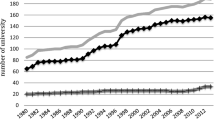Abstract
In the years 1957–1966 the universities of Canada, as a result of a vast injection of federal funds directly into higher education, appeared to be at the beginning of a long period of development, largely autonomous, and national in scope and outlook. By the late 1960s the provincial governments, motivated partly by what they perceived as an infringement of their constitutional rights, partly no doubt by a sense that they could make better use of the vast sums involved, persuaded the federal government to direct its grants to them. The more populous provinces then found it desirable to develop advisory bodies to counsel the governments on the broader problems of universities, especially fiscal ones. In Ontario the Ontario Council of University Affairs was created for this purpose. It was conceived of as a buffer body to stand between government and universities, serving both. In fact it had no statutory authority. Its advice to the government on the growing financial needs of universities was persistently rejected, while its advice to the universities themselves to develop methods of genuine cooperation and coordination for the sake of the whole system was largely ignored. The Council began to assume a measure of authority, but the Minister was not satisfied with the state of affairs, and in December 1983 she abruptly announced the appointment of a three-man commission to devise a plan for reshaping the university system, including “clarifying” the role of the Ontario Council on University Affairs. That role is now almost totally unclear.
Similar content being viewed by others
References
Bissell, Claude T. (ed.) (1957). Canada's Crisis in Higher Education. Toronto: University of Toronto Press.
Bladen, V. W., Dugal, L. P., McCutcheon, M. W. and Ross, H. I. (1965). Financing Higher Education in Canada. Toronto: University of Toronto Press.
Commission on Post-Secondary Education in Ontario (1972). The Learning Society. Toronto: Ministry of Government Services.
Corry, J. A. (1970). Farewell the Ivory Tower. Montreal and London: McGill-Queen's University Press.
Council of Ontario Universities (1982). Federal-Provincial Relations and Support for Universities.
Dadson, D. F. (ed.) (1966). On Higher Education. Toronto: University of Toronto Press.
Dunton, Davidson and Patterson, Dorothy (eds.) (1962). Canada's Universities in a New Age. Ottawa: Le Droit.
Gauthier, Germain (1983). “Coordination and Governance of Postsecondary Education: Canadian Experiences.” (Paper delivered at ACE/AUCC joint meeting, Toronto, Oct. 11–14, 1983).
President's Research Committee (1966). From the Sixties to the Seventies. Toronto: Committee of Presidents of Universities of Ontario.
Stephenson, the Honourable Bette, Minister of Colleges and Universities (1983). Statement to the Legislature, December 15, 1983.
Author information
Authors and Affiliations
Rights and permissions
About this article
Cite this article
Smith, J.P. Tidy minds, untidy solutions: University organization in Ontario. High Educ 13, 569–581 (1984). https://doi.org/10.1007/BF00128566
Issue Date:
DOI: https://doi.org/10.1007/BF00128566




